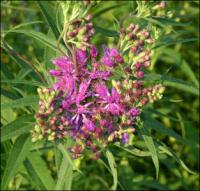Description
Heads of numerous deep, royal purple, platter-forming flower several feet high above in late summer
Heads of numerous deep, royal purple, platter-forming flower several feet high above in late summer
Heads of numerous deep, royal purple, platter-forming flower several feet high above in late summer
OUT OF STOCK
Sprays of large, single warming yellow daisies, blushed with apricot top a bushy mound of light green leaves, blooms late-summer to late-fall
Size: 1-2’ x 2-3’ and spreading
Care: Full sun to part shade, tolerates normal, sandy or clay soil
Wildlife Value: Attracts bees, butterflies and birds. Deer resistant.
One of the rubellum hybrids, Hybridized in the 1930’s
OUT OF STOCK
Wine-red petals of bell-shape with yellow centers flowers in early spring. Fun, furry foliage and Medusa-like seed heads.
Size: 12-20” x 4-8”
Care: sun in well-drained to moist well-drained soil
Native: Europe
Wildlife Value: Deer resistant, early pollen source for bees.
Called Pasqueflower because it blooms at Easter time. Variety rubra considered a separate species, not a variety, by Caspar Bauhin in Theatri botanici, 1671. Illustrated in Gerard’s Herball, 1636.
Golden daisies waive at the sun from July to September, its cup shaped leaves hold water where butterflies drink & bathe
Can not ship to: Connecticut and New York
Size: 7’ x 3’
Care: full sun to part shade in moist to moist well-drained soil
Native: Central North America, native to Wisconsin.
Awards: England’s Royal Horticultural Society Award of Merit
Sap used by Native Americans to chew and freshen breath. Also used to cure colds, neuralgia, fever, and liver disorders. The Chippewa used it to stop lung hemorrhaging, menstrual bleeding, and cure chest pain. Winnebago drank a potion from the plant to purify themselves before a buffalo hunt. For the Iroquois it cured paralysis, prevented children from seeing ghosts and illness caused by the dead. Lakota Sioux children sometimes chewed resin like chewing gum. An infusion of the whole plant is used to rid horses and humans of intestinal worms. An infusion of the leaves is used to loosen phlegm in the lungs. Described and classified in 1753.
Balloon shaped buds as though puffed with air, open to white, five-petal bells from mid-summer to early fall.
Size: 24" x 12"
Care: Sun to part shade in moist well-drained soil, heat and drought tolerant. Deadhead for rebloom.
Native: Eastern Asia
Wildlife Value: attracts hummingbirds, bees & butterflies
Awards: England's Royal Horticultural Society Award of Garden Merit.
Platycodon is Greek from platys meaning “broad” and kodon meaning “bell”, referring to the shape of the flower. Cultivated in China for hundreds of years where it is called Jie-geng. The Chinese used the root boiled to cure a chill in the stomach. Mentioned in Man’yoshu, a Japanese anthology of poems written in the 8th century. German botanist Johann Gmelin first collected this in Siberia in 1754. Gmelin’s Siberian mission, sponsored by Catherine the Great, took 10 years and nearly killed him. Gmelin introduced it to European gardens by 1782. Robert Fortune found the white form in a nursery near Shanghai and sent it to England in 1845.

